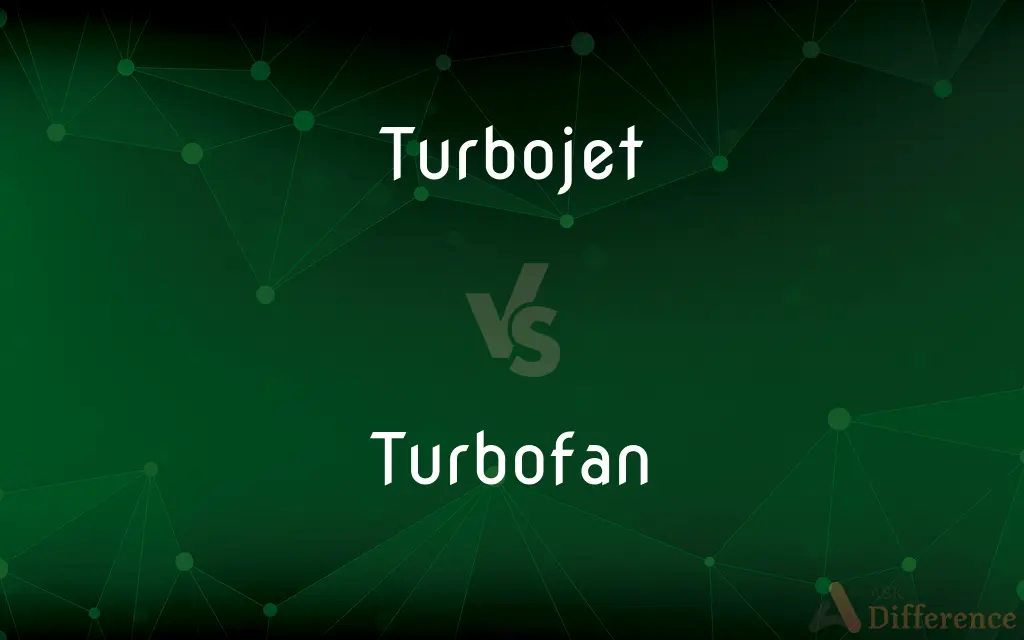Turbojet vs. Turbofan — What's the Difference?
By Fiza Rafique & Maham Liaqat — Updated on April 15, 2024
Turbojet engines are older, simpler in design and ideal for high-speed, high-altitude flight; turbofan engines are more modern, featuring a fan for increased efficiency, making them suitable for commercial aviation.

Difference Between Turbojet and Turbofan
Table of Contents
ADVERTISEMENT
Key Differences
Turbojet engines, utilized primarily in military and high-speed aircraft, work by compressing air and mixing it with fuel for combustion, producing a high-speed exhaust jet that propels the aircraft. In contrast, turbofan engines include an additional fan at the front, which pushes a large volume of air around the outside of the engine, enhancing thrust and fuel efficiency.
The design of a turbojet is relatively simple with fewer moving parts, which generally translates to lower maintenance costs but higher fuel consumption. On the other hand, turbofans are more complex and costly to maintain but significantly reduce fuel costs, making them economically preferable for commercial use.
Turbojets are characterized by their high exhaust speeds, making them efficient at supersonic speeds and suitable for applications like fighter jets and the Concorde. Whereas turbofans are optimized for subsonic speeds, with their bypassed air reducing noise and improving thrust efficiency, ideal for passenger jets.
Noise levels in turbojets are considerably higher due to the high-speed exhaust jet. Turbofan engines, by incorporating a large fan and bypassing a significant portion of air, generate less noise, aligning better with modern noise regulations in aviation.
The operational efficiency of turbojets decreases at slower speeds and lower altitudes; thus, they are less suited for typical commercial flight paths. Conversely, turbofans deliver optimal performance over a wide range of speeds and altitudes, meeting the diverse requirements of commercial aviation.
ADVERTISEMENT
Comparison Chart
Design
Simpler, fewer parts
More complex, includes a fan
Efficiency
High at supersonic speeds
High at subsonic speeds, more fuel-efficient
Usage
Military aircraft, high-speed transports
Commercial and cargo aircraft
Noise
Higher
Lower due to bypassing air
Maintenance Cost
Generally lower, due to simplicity
Higher, due to complexity
Compare with Definitions
Turbojet
Characterized by high noise levels.
The roar of a turbojet engine is noticeably louder than that of newer engine types.
Turbofan
More components mean higher maintenance requirements.
The complexity of turbofan engines requires meticulous maintenance schedules.
Turbojet
An engine that propels aircraft by ejecting a high-speed jet of gases.
Turbojet engines powered early fighter jets effectively.
Turbofan
A type of jet engine that uses a large fan to increase efficiency.
Most modern passenger planes use turbofan engines for better fuel economy.
Turbojet
Operates efficiently at high altitudes and speeds.
Turbojets were used in the Concorde for their performance at high speeds.
Turbofan
Better suited for varied flight conditions.
Turbofan engines perform efficiently across a range of altitudes and speeds.
Turbojet
Known for simplicity and fewer components.
The maintenance of a turbojet is generally less complex due to its design.
Turbofan
Provides high thrust at lower speeds and quieter operation.
Turbofans are preferred for commercial flights due to their reduced noise.
Turbojet
Often used in military applications.
Older military jets typically feature turbojet engines for their speed capabilities.
Turbofan
Dominant in the commercial aviation sector.
Airlines choose turbofan engines to optimize fuel costs and meet environmental standards.
Turbojet
The turbojet is an airbreathing jet engine, typically used in aircraft. It consists of a gas turbine with a propelling nozzle.
Turbofan
The turbofan or fanjet is a type of airbreathing jet engine that is widely used in aircraft propulsion. The word "turbofan" is a portmanteau of "turbine" and "fan": the turbo portion refers to a gas turbine engine which achieves mechanical energy from combustion, and the fan, a ducted fan that uses the mechanical energy from the gas turbine to accelerate air rearwards.
Turbojet
A jet engine having a turbine-driven compressor and developing thrust from the exhaust of hot gases.
Turbofan
A turbojet engine in which a fan supplements the total thrust by forcing air directly into the hot turbine exhaust.
Turbojet
Anrcraft in which a turbojet is used.
Turbofan
An aircraft in which a turbofan is used. In both senses also called fanjet.
Turbojet
(aeronautics) A jet engine that develops thrust solely from high-speed exhaust gases expelled from a turbine that drives a compressor.
Turbofan
(aviation) A turbojet engine having a (typically ducted) fan that forces air directly into the hot exhaust and obtains a portion of the thrust from the turbojet and a portion from the turbojet section.
Turbojet
Airplane powered by a turbojet engine
Turbofan
Jet engine in which a turbine drives air to the burner
Turbojet
Jet engine in which a turbine drives air to the burner
Common Curiosities
How do turbofans reduce noise compared to turbojets?
The large fan in turbofans helps bypass air, which muffles and reduces the speed of the exhaust, lowering noise levels.
Are turbofans suitable for supersonic flight?
Turbofans are generally less suitable for supersonic flight compared to turbojets, which are optimized for high speeds.
Can turbojet engines be used in commercial aircraft?
While technically possible, turbojets are not commonly used in commercial aircraft due to their high fuel consumption and noise levels.
What makes turbofan engines more fuel-efficient than turbojets?
Turbofans are more efficient due to their ability to bypass a portion of air around the combustion chamber, reducing fuel consumption.
What is the primary advantage of a turbojet over a turbofan?
The primary advantage of a turbojet is its simplicity and effectiveness at high speeds and altitudes.
What types of aircraft still use turbojet engines?
Some high-speed military aircraft and vintage jets still use turbojet engines.
How do maintenance costs compare between turbojets and turbofans?
Turbojets generally have lower maintenance costs due to their simpler design, while turbofans are costlier to maintain.
What are the environmental benefits of turbofan engines?
Turbofan engines contribute to reduced carbon emissions and lower noise pollution.
Why are turbojets preferred in military aircraft?
Turbojets are ideal for military use due to their high speed and efficiency at high altitudes.
What is a key drawback of using turbojet engines today?
A key drawback is their inefficiency at lower speeds and altitudes, making them less ideal for most modern aviation needs.
How has the development of turbofans impacted aviation?
Turbofans have made air travel more economical and environmentally friendly due to their enhanced fuel efficiency and reduced noise.
Can turbojet engines operate efficiently at low altitudes?
Turbojets are less efficient at low altitudes and speeds, which restricts their use to specific aircraft types.
What innovations are associated with turbofan engines?
Innovations include increased bypass ratios and advanced noise reduction technologies.
Why might an airline choose turbofan engines for its fleet?
Airlines prefer turbofan engines for their fuel efficiency, operational cost savings, and compliance with noise regulations.
How do the speeds of turbojet and turbofan engines compare?
Turbojet engines achieve higher speeds, making them suitable for supersonic flight, while turbofan speeds are optimized for commercial air travel.
Share Your Discovery

Previous Comparison
Gnome vs. Dwarf
Next Comparison
Categorize vs. ClassifyAuthor Spotlight
Written by
Fiza RafiqueFiza Rafique is a skilled content writer at AskDifference.com, where she meticulously refines and enhances written pieces. Drawing from her vast editorial expertise, Fiza ensures clarity, accuracy, and precision in every article. Passionate about language, she continually seeks to elevate the quality of content for readers worldwide.
Co-written by
Maham Liaqat














































